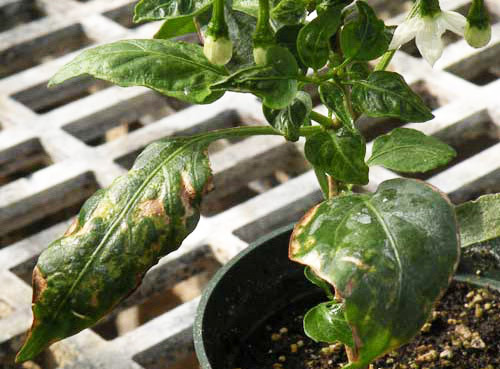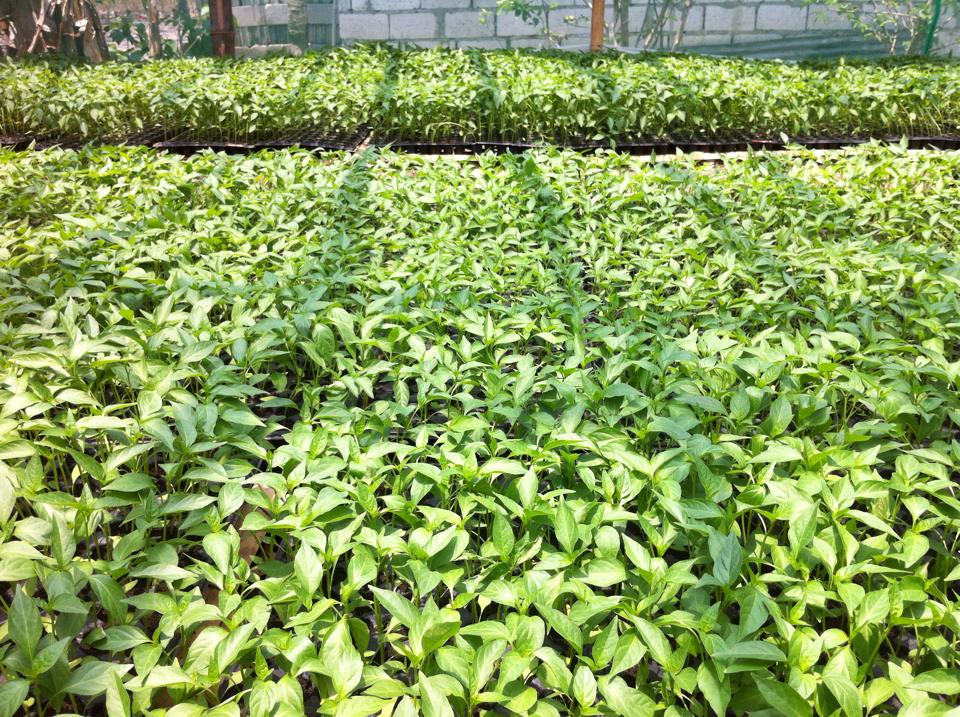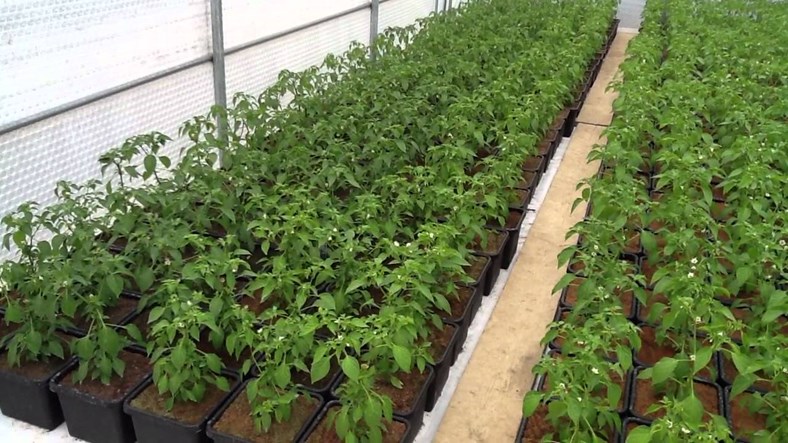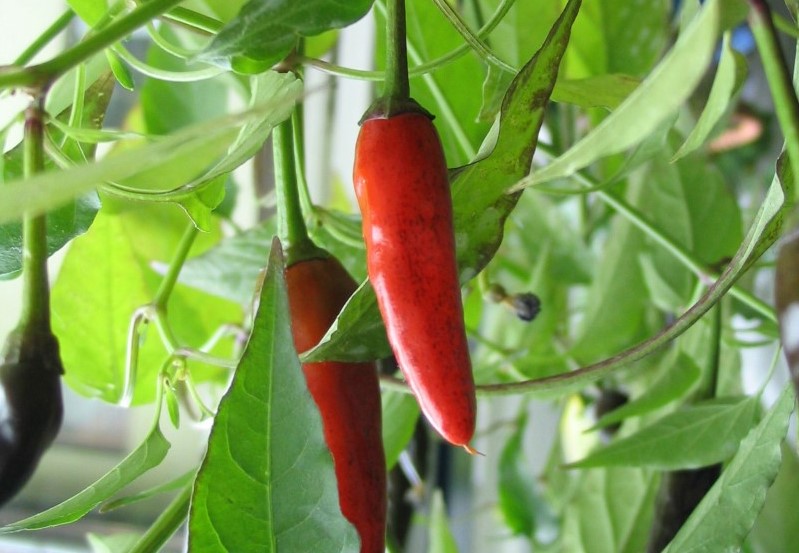- Thrips insect both adult and nymph cause damage to plants.
Their adults are small, thin, and have brown feathers, the same nymphs are of a pale size. - Wrinkles are seen in the leaves of Chili infected with thrips and these leaves turn upwards.
- In the initial stage stop the growth of plants, production of flowers, and production of fruits.
- To control this, spray Profenophos 50% EC @ 30 ml or Acephate 75% SP @ 18 gm or Fipronil 5% SC @ 25 ml mixed with 15 liters of water.
Identification and prevention measures of damping off disease in chilli nursery
- This disease can occur in two stages in the nursery. In the first stage, before germination, the chilli seeds rot from the fungus, in the second stage after germination, the stem base starts to rot.
- Due to this weak and sticky stem, water-filled, brown, brown, or black sores are visible.
- Due to this weak and sticky stem, water-filled, brown, or black sores are visible.
- After this, the stem shrinks and the plant falls to the ground and dies.
- To prevent this, Trichoderma viridi 4 gm or Carboxin 37.5% + Thiram 37.5% WP 3 gm per kg of seed treatment.
- To prevent this, spray 30 gm Thiophanate methyl 70% WP or 30 gm metalloxyl 4% + Mancozeb 64% WP with 15 liters of water spray in the soil.
Method of sowing Chilli seeds in nursery
It is very important to keep some things in mind while sowing chilli seeds in the nursery. This produces good seedlings in the nursery.
- To prepare chilli plantation, firstly sowing the seeds in 3 x 1.25 m size beds.
- These beds should be raised 8-10 cm high from the ground so that seeds and plants do not rot due to water accumulation.
- Add 750 gm DAP, 100 gm Incryl (seaweed, amino acids, humic acid and Mycorrhiza) and 250 gm Trichoderma viride per square meter to the soil in 150 kg FYM to increase plant growth with soil structure. and it also protects against harmful soil borne fungal diseases.
- The nursery requires 60-80 grams of chilli seeds for one acre field.
- Sowing seeds by making 0.5-1 cm deep drains at a distance of 5 cm in the beds.
- After sowing, continue irrigating as needed.
How to choose a location for planting chili nursery?
While choosing the place for planting chilli nursery, we can get good production from its crop by keeping some things in mind.
- The land should be fertile, loamy soil, weed free and have a good drainage system.
- Do not choose acidic or alkaline soil.
- Near the nursery should not have very large trees.
- The nursery has long sunlight.
- Near the nursery should have irrigation facilities.
- The chosen area should be high so that water does not stay.
- Do not build a nursery repeatedly in one place.
Know the benefits of soil treatment in chilli nursery
- Many major insect pests and soil-borne diseases are found in the soil, which damages the crops in various ways. Mainly termites, white grub, cutworm, nematodes, etc. can be destroyed by soil treatment.
- Soil-borne spores of fungus/ bacterial diseases are also found in the soil, which infects various stages of the plant under favorable conditions and causes loss in crop production.
- Soil treatment leads to the complete development of chilli plants, complete nutritional growth, and rich quality production.
- Along with improving soil structure, the attack of sucking pests and diseases also reduces.
- After the attack of pests and diseases, the treatment by chemicals is used more, as a result of which the cost of production increases due to more chemical expenditure.
Nursery management using scientific method in Chilli
- To prepare chilli plants, first seeds should be sown in 3 x 1.5 m size land and these beds should be raised 8-10 cm high from the ground so that the seeds and the plants do not rot due to water accumulation.
- One acre area requires 100 grams of chili seeds. Add 750 gm DAP, 100 gm Incryl (seaweed, amino acids, humic acid, and mycorrhiza) and 250 gm Trichoderma viride per square meter to the soil in 150 kg FYM to increase plant growth with soil structure. and it also protects against harmful soil-borne fungal diseases.
- 8-10 days after sowing, spray 10 gm thiamethoxam 25% WG in 15 liters of water for aphid and jassid insects and another spray after 20-22 days, 5 gm fipronil 40% + imidacloprid 40% WG with 15-liter water.
- After 15-20 days of sowing, the problem of damping-off in the nursery so spray or drenching with 0.5 gm of thiophanate methyl 70 WP per square meter or spray 30 gm of metalaxyl 4% + mancozeb 64% WP in 15 liters of water.
Problems and solutions of sucking pest in chilli:-
Sucking pests like aphids, jassids, and thrips are the main problem of chilli crop. These pests damage by sucking plant sap from the green part of the plant so the leaves are wrinkled and premature defoliation. Infections of sucking pests can increase the likelihood of fungal and viral diseases.
Therefore, timely control of these insects is necessary: –
- Spray of Profenophos 50% EC @ 400 ml/acre. OR
- Spray of Acephate 75% SP @ 250 gm/acre. OR
- Spray of Lambda-cyhalothrin 4.9% CS @ 200-250 ml/acre. OR
- Spray of Fipronil 5% SC @ 300-350 ml/acre should be done. For More Information, Please call on toll-free no. 1800-315-7566.
Like and share with other farmers by clicking on button below.
ShareChilli nursery spray schedule
The nursery is well prepared for good yield If the plant will remain healthy in the nursery, then the plant will be very strong after transplanting in the field, so take proper care of the plant in the nursery. In order to prepare good plants, gramophone advised the farmer, spray three times in the nursery, which is as follows.
First Spray at 12 DAS:-
- Thiamethoxam 25% WP 8 gm/pump + Amino acid 20 ml/pump. ( To control soil-borne pest and seedling nutrition )
Second Spray at 20 DAS:-
- Metalaxyl-M ( Mefanoxam ) 4% + Mancozeb 64% WP 30 gm/pump. ( To control soil-borne diseases like damping off )
Third Spray at 28 DAS:-
- Thiamethoxam 25% WP 8-10 gm/pump + Humic Acid 10-15 gm/pump. ( To control soil-borne pest )
Like and share with other farmers by clicking on the button below.
ShareNursery Management in Chilli
The nursery is well prepared for good yield If the plant will remain healthy in the nursery, then the plant will be very strong after transplanting in the field, so take proper care of the plant in the nursery. In order to prepare good plants, gramophone advised the farmer, spray three times in the nursery, which is as follows.
- First Spray at 12 DAS:- Thiamethoxam 25% WP 8 gm/pump + Amino acid 20 ml/pump. ( To control soil-borne pest and seedling nutrition )
- Second Spray at 20 DAS:- Metalaxyl-M ( Mefanoxam ) 4% + Mancozeb 64% WP 30 gm/pump. ( To control soil-borne diseases like damping off )
- Third Spray at 28 DAS:- Thiamethoxam 25% WP 8-10 gm/pump + Humic Acid 10-15 gm/pump. ( To control soil-borne pest )
Like and share with other farmers by clicking on the button below.
ShareHow to prepare Nursery for chilli
- TIME: Ideally nursery should be prepared between the 1st May to 30th May.
- The first step is to pulverize the soil with a fine tilth.
- An area of 60 sqm should be divided into 16-18 beds measuring 3meters/1.25 meters in length and width, this should be enough for 1 acre of transplanting.
- 150Kg decomposed FYM with 750gm DAP should be enough to fertilize an area of 60sqm.
- Thiophanate methyl 0.5gm/sqm should be applied to avoid fungal infestation.
- Seed rate of chili is 100gm/Acre.
Like and share with other farmers by clicking on button below.
Share








